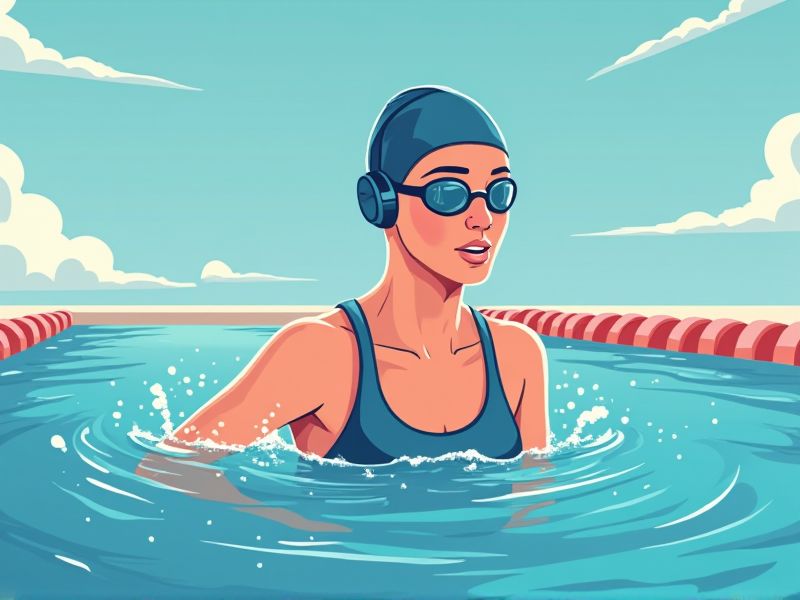
Michael Phelps emphasizes that **"I think goals should never be easy. They should force you to work, even if they are uncomfortable at the time"**. This mindset is crucial for swimmers as it encourages them to push beyond their comfort zones, fostering growth and improvement. By setting challenging goals, swimmers can develop resilience and a strong work ethic, which are essential for achieving success in the sport. Phelps' approach highlights the importance of perseverance and dedication in overcoming obstacles and reaching one's full potential in swimming.
How to Be Better at Swimming
Optimize stroke technique.
Focusing on stroke technique significantly boosts efficiency and reduces drag in the water. Drilling specific elements like the catch, pull, and kick allows you to fine-tune your movements and enhance propulsion. Consistent video analysis and expert feedback can pinpoint inefficiencies, leading to targeted adjustments that improve overall performance. Combining technical refinement with strength and endurance training builds the muscle memory essential for smoother, faster strokes.
Enhance breathing efficiency.
Enhancing breathing efficiency enables you to maintain a consistent stroke rhythm while providing your muscles with ample oxygen. Optimizing your breathing patterns minimizes fatigue during long swims, as better oxygen delivery directly supports sustained muscle performance. Practicing controlled breathing techniques improves stroke timing and helps reduce the build-up of lactic acid, which is essential for endurance. Strengthening respiratory muscles through targeted exercises can lead to measurable gains in overall swimming speed and recovery time.
Build endurance.
Building endurance helps your body efficiently use oxygen, which is crucial for maintaining a consistent pace during long swims. Regular interval training, incorporating varied intensities and distances, challenges your cardiovascular system and improves your energy management over time. Gradually increasing the length and intensity of your workouts forces your muscles to adapt, reducing fatigue and enhancing overall performance in the water. By consistently pushing your endurance limits through structured practice and cross-training, you develop the robust stamina needed to excel in competitive or recreational swimming.
Integrate speed drills.
Speed drills boost your power output by forcing your muscles to contract more quickly, which in turn improves stroke efficiency over time. Integrating speed drills increases your anaerobic capacity, leading to better performance during sprints and competitive events. Regularly incorporating these drills into your workout not only challenges your cardiovascular system but also enhances your technique under pressure. Tracking your progress with timed intervals helps optimize your workout and ensures the drills effectively translate into faster swim speeds.
Refine body alignment.
Refining your body alignment directly enhances hydrodynamic efficiency, reducing drag and improving propulsion in the water. Keeping your head, spine, and hips aligned minimizes resistance, allowing for smoother and more effective strokes. Consistently practicing drills that focus on core stability and positioning reinforces proper alignment throughout your swim. Regular video analysis and feedback ensure that each slight adjustment contributes to a more streamlined and powerful technique.
Strengthen kicking.
Developing a stronger kick creates a direct boost to your overall propulsion in the water. Engaging in drills like flutter kicks and using tools such as kickboards focuses on the muscles required for a more powerful kick. Strengthening your kicking technique minimizes drag and improves body alignment, which in turn enhances your swimming efficiency. Consistently integrating these targeted exercises into your training routine leads to measurable improvements in speed and endurance.
Practice interval training.
Interval training enhances cardiovascular strength by alternating between periods of high-intensity swimming and recovery. This method boosts your aerobic capacity and improves your speed, which are crucial components for competitive swimming performance. Incorporating sprint intervals into your routine helps your body adapt to rapid bursts of energy expenditure, thereby improving overall efficiency in the water. Regularly tracking intervals and rest periods with precise measurements will provide clear data to optimize your technique and endurance over time.
Utilize cross-training.
Cross-training targets different muscle groups, which in turn strengthens the core and leg muscles vital for efficient swimming. Engaging in activities such as weight training, running, or cycling can enhance overall stamina and reduce the risk of repetitive strain injuries. This varied workout regimen improves both cardiovascular health and muscular balance, leading to a more powerful and controlled swim stroke. Incorporating diverse exercises also helps break routine plateaus, driving consistent performance improvements in the water.
Monitor performance.
Consistently track lap times, stroke counts, and heart rate to build an objective picture of your swimming performance. Using wearable sensors and swim tracking software provides reliable metrics that help identify which parts of your stroke need improvement. Analyzing your performance trends over weeks allows targeted adjustments in your training that yield measurable benefits. Incorporating data-driven self-assessment enables continuous refinement of technique, stamina, and overall efficiency in the water.
Seek expert coaching.
Proper coaching provides tailored insights into stroke mechanics and breathing techniques that significantly boost performance. Working with an expert helps you identify technical flaws and adjust your training routine with advanced, data-backed strategies. This focused guidance not only refines your skills but also minimizes risks of injury and accelerates measurable improvements. Regular feedback from a coach creates a positive cycle for continuous progress in both endurance and speed.
Summary
Optimizing stroke technique reduces drag and increases propulsion, allowing swimmers to cover more distance with less energy waste. Enhancing breathing efficiency supports a steady oxygen supply, which is crucial for sustaining performance during long sessions. Building endurance through targeted conditioning improves cardiovascular strength and overall stamina in the water. Together, these strategic adaptations enable a comprehensive boost in swimming performance based on measurable improvements.
